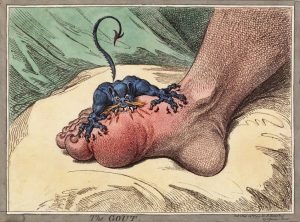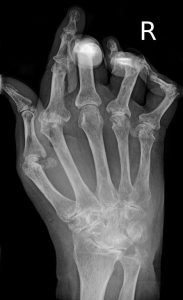“Rituximab versus Cyclophosphamide for ANCA-Associated Vasculitis”
by the Rituximab in ANCA-Associated Vasculitis-Immune Tolerance Network (RAVE-ITN) Research Group
N Engl J Med. 2010 Jul 15;363(3):221-32. [free full text]
—
ANCA-associated vasculitides, such as granulomatosis with polyangiitis (GPA, formerly Wegener’s granulomatosis) and microscopic polyangiitis (MPA) are often rapidly progressive and highly morbid. Mortality in untreated generalized GPA can be as high as 90% at 2 years. Since the early 1980s, cyclophosphamide (CYC) with corticosteroids has been the best treatment option for induction of disease remission in GPA and MPA. Unfortunately, the immediate and delayed adverse effect profile of CYC can be burdensome. The role of B lymphocytes in the pathogenesis of these diseases has been increasingly appreciated over the past 20 years, and this association inspired uncontrolled treatment studies with the anti-CD20 agent rituximab that demonstrated promising preliminary results. Thus the RAVE trial was performed to compare rituximab to cyclophosphamide, the standard of care.
Population: ANCA-positive patients with “severe” GPA or MPA and a Birmingham Vasculitis Activity Score for Wegener’s Granulomatosis (BVAS/WG) of 3+.
notable exclusion: patients intubated due to alveolar hemorrhage, patients with Cr > 4.0
Intervention: rituximab 375mg/m2 IV weekly x4 + daily placebo-CYC + pulse-dose corticosteroids with oral maintenance and then taper
Comparison: placebo-rituximab infusion weekly x4 + daily CYC + pulse-dose corticosteroids with oral maintenance and then taper
Outcome:
primary end point = clinical remission, defined as a BVAS/WG of 0 and successful completion of prednisone taper
primary outcome = noninferiority of rituximab relative to CYC in reaching 1º end point
authors specified non-inferiority margin as a -20 percentage point difference in remission rate
subgroup analyses (pre-specified) = type of ANCA-associated vasculitis, type of ANCA, “newly-diagnosed disease,” relapsing disease, alveolar hemorrhage, and severe renal disease
secondary outcomes = rate of disease flares, BVAS/WG of 0 during treatment with prednisone at a dose of less than 10mg/day, cumulative glucocorticoid dose, rates of adverse events, SF-36 scores
Results:
197 patients were randomized, and baseline characteristics were similar among the two groups (e.g. GPA vs. MPA, relapsed disease, etc.). 75% of patients had GPA. 64% of the patients in the rituximab group reached remission, while 53% of the control patients did. This 11 percentage point difference among the treatment groups was consistent with non-inferiority (p < 0.001). However, although more rituximab patients reached the primary endpoint, the difference between the two groups was statistically insignificant, and thus superiority of rituximab could not be established (95% CI -3.2 – 24.3 percentage points difference, p = 0.09). Subgroup analysis was notable only for superiority of rituximab in relapsed patients (67% remission rate vs. 42% in controls, p=0.01). Rates of adverse events and treatment discontinuation were similar among the two groups.
Implication/Discussion:
Rituximab + steroids is as effective as cyclophosphamide + steroids in inducing remission in severe GPA and MPA.
This study initiated a major paradigm shift in the standard of care of ANCA-associated vasculitis. The following year, the FDA approved rituximab + steroids as the first-ever treatment regimen approved for GPA and MPA. It spurred numerous follow up trials, and to this day expert opinion is split over whether CYC or rituximab should be the initial immunosuppressive therapy in GPA/MPA with “organ-threatening or life-threatening disease.”
Non-inferiority trials are increasingly common, and careful attention needs to be paid to their methodology. Please read more in the following two articles: [http://www.nejm.org/doi/full/10.1056/NEJMra1510063] and [http://www.rds-sc.nihr.ac.uk/study-design/quantitative-studies/clinical-trials/non-inferiority-trials/]
Further Reading/References:
1. “Wegener granulomatosis: an analysis of 158 patients” (1992)
2. RAVE @ ClinicalTrials.gov
3. “Challenges in the Design and Interpretation of Noninferiority Trials,” NEJM (2017)
4. “Clinical Trials – Non-inferiority Trials”
5. RAVE @ Wiki Journal Club
6. RAVE @ 2 Minute Medicine
Summary by Duncan F. Moore, MD

